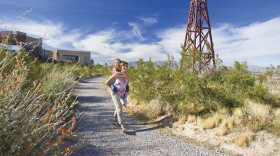At first glance, the Tikaboo Valley in Lincoln County seems roughly identical to any number of other valleys in Southern Nevada. In dry years, which are increasingly common, the valley floor bears a sparse cover of perennial shrubs typical of this part of the northern Mojave Desert. Chollas, prickly pear, and barrel cacti, and non-succulent yet well-armed shrubs like shadscale and menodora all stand ready to perforate the skin of incautious hikers.
In wetter years, though, the valley becomes a lush, wild garden, with red paintbrush and hot pink Gilia, Apache plume with its white flowers that become graceful feathery seeds, desert marigolds, and Delphiniums with heartbreakingly pale blue blossoms. My first visit to the Tikaboo Valley, in May 2005, followed a record-breaking wet winter. I stood a few hundred yards off Route 375 and breathed in a heady but unidentifiable scent of a million sun-warmed blossoms.
When I made that visit to Tikaboo, few other people were there to appreciate the local flora. The majority of folks I’d met who had heard of the place had come to know it because of its proximity to the extraterrestrial-themed businesses in Rachel, and because Tikaboo Valley was about as close to Area 51 as a civilian could get. Every half hour or so a driver would speed along 375 on their way between the Pahranagat Valley to the east and the Greater Tonopah Metropolitan Area to the northwest.
Me? I was there for the Joshua trees, because they’re what makes Tikaboo truly special, and even more so as the desert warms.
THE JOSHUA TREE (Yucca brevifolia) is native to the Mojave Desert in Nevada, California, Arizona, and Utah. It’s long been known that Joshua trees on the east side of the species’ range are different from those growing to the west. For much of the last century, the two kinds of tree have been treated either as varieties (meaning they have some notable but superficial differences) or subspecies (basically a variety that has been geographically separated from its kin). The name “jaegeriana” has been tagged onto the eastern trees, in honor of botanist Edmund Jaeger. If you consider the two kinds of trees subspecies, then the western would be properly termed Yucca brevifolia brevifolia and the eastern Yucca brevifolia jaegeriana.
Eastern and western Joshua trees can be hard to distinguish if you’re just getting to know them. Both types grow sharp-pointed leaves in rosettes at the ends of ungainly branches. Both flower in spring after rainy winters, and both develop large pods full of seeds that can hang onto their parents for months if not years. After a few weeks in Joshua tree country, however, the differences between the two kinds become easier to discern. Those jagged leaves on the western trees can be a foot or more long, while the eastern trees’ leaves rarely surpass eight inches. The eastern trees also branch much more readily than the western trees.
Still, the most reliable way of telling western and eastern trees apart is your location. The western trees grow in a broad arc from Beatty, Nevada, westward toward the north end of Death Valley National Park, and then southward toward Los Angeles, making a hairpin left turn toward Joshua Tree National Park. The eastern trees are found closer to the Colorado River drainage, venturing into California in the vicinity of Mojave National Preserve and Avi Kwa Ame National Monument, and extending eastward into Arizona and Utah. In between, a broad swath of treeless land, where the elevation is lower than the trees’ preferred range of 2,500-6,000 feet above sea level, arcs from Lake Havasu through the middle of Death Valley, and then eastward into the Nevada National Security Site. If you’re west of that swath, you’re keeping company with the western trees, while those trees in the Vegas Valley or St. George, Utah, or Wickenburg, Arizona, are the eastern kind.
There is, however, one exceptional place, where the two kinds of Joshua trees’ ranges overlap. That exceptional place is the Tikaboo Valley.
“The interest in Tikaboo Valley for me,” says California State University Northridge evolutionary biologist Jeremy Yoder, “is that it’s the only place we know where we have both groups of Joshua tree. From a biodiversity perspective, it is a unique community.”
For more than 15 years, Yoder has been studying the relationships between Joshua trees and their pollinators, the Joshua tree moth. Like almost all other yuccas, Joshua trees are entirely dependent on a single species of moth to pollinate their flowers. That dependence is mutual: The moths need the Joshua trees to reproduce themselves.
As Joshua tree flowers open in spring, some as-yet-unknown signal prompts Joshua tree moth pupae resting deep underground to emerge from the soil as adults. They mate, and the female moth then flits from flower to flower, gathering sticky pollen from the Joshua tree flowers’ anthers and holding that pollen in a glob underneath where her chin would be if she had a chin.
Flying to other flowers, she unfurls a long appendage called an ovipositor, inserts it into the flower, and lays an egg in the ovary. She then takes a bit of pollen from her stash and deliberately crams it into the flower’s pistils, starting the process of making new Joshua tree seeds. The fruit develops, the seeds inside it grow, and the moth egg hatches to allow the larva inside to eat some of those seeds. Before long, about a fifth of the seeds in its native fruit eaten, the larva emerges from the Joshua tree fruit and drops to the ground, where it burrows into the soil and pupates.
A Joshua tree’s fruit doesn’t fall from the trees readily. Instead, the seeds must wait for someone to remove them from the tree and distribute them to places where they might be able to germinate. In the last few years, a hypothesis that most of that distribution used to be done by the now-extinct Shasta ground sloth has gained popularity. Be that true or not, these days the smaller and much less extinct antelope ground squirrel does a pretty good job of caching the seeds and then forgetting where they put them. A couple percent of the total forgotten seeds might just germinate and survive.
It’s a textbook tale of symbiosis, but it gets more complicated.
In 2003, Yoder’s mentor entomologist Olle Pellmyr at the University of Idaho determined that the moth pollinating the eastern trees was
a distinct species from the western trees’ moth partner. The western moth had been dubbed Tegeticula synthetica a century prior;
Pellmyr christened the sister species T. antithetica.
Each moth species is great at fertilizing its own type of Joshua tree, but neither does a spectacular job with the other kind. A western moth can successfully pollinate eastern trees’ flowers, but she tends to damage the flowers in the process, meaning a lower percentage of successful pollination. Meanwhile, eastern moths seem to be entirely unable to work with the western flowers. The two tribes of trees are largely reproductively isolated, which is generally considered the hallmark of being a distinct species. As a result, more and more botanists treat Joshua trees as being two species: Yucca brevifolia for the western trees and Yucca jaegeriana for the eastern.

THAT CONSENSUS MAY well change, as the two kinds of Joshua trees aren’t completely unable to crossbreed. In fact, the Tikaboo Valley does have a patch of Joshua trees where there’s clearly been some hybridization going on. But even that isn’t as simple as it sounds. The first generation of hybrids between eastern and western Joshua trees seems to be spectacularly unfit for life in the desert. Chris Smith, a biologist at Willamette University and the founder of the Joshua Tree Genome Project, says that his teams do not find trees in that first generation. They seem to only live long enough to set seed if pollinated by a western moth with pollen from a western tree or another hybrid. “The hybrids that we can find look like they are what we would call an advanced generation hybrid,” Smith says. “It’s not the result of a brevifolia and jaegeriana making seed recently, it’s several generations down the road.”
Is that a little murky? Smith has a helpful metaphor. “An example that one of my colleagues uses in talking about this are labradoodles. The Joshua trees that we find (in the Tikaboo Valley) are not the offspring of a Labrador and a poodle. They are a labradoodle that’s been crossed to another labradoodle or a Labrador.”
This would all be interesting enough as an academic exercise in species concepts. But the stakes are higher than they might be if we were discussing different strains of petunia or apple tree. Between desert wildfires, drought, and deliberate destruction of habitat, both species of Joshua trees face an uncertain future in our warming world. Recent research indicates that the two kinds of Joshua tree may have different chances of surviving our human-caused climate crisis, with the eastern species slightly more adapted to extended drought and higher temperatures.
In another century, we might have some answers. Tikaboo Valley is at the northern end of both tree species’ range, and north is the direction in which the trees and moths will need to migrate if they are to have offspring living in the 24th century. Seeing which species thrives will be illuminating.
One needn’t wait for that data set, however, to learn a lot from the Tikaboo Valley. “You could fairly say that Tikaboo is a kind of a nexus of all the history of human activity in the Mojave,” says Yoder. “It’s active grazing land right now, but it’s also adjacent to Air Force and Department of Energy properties. You can be out in the middle of the desert and see nobody and hear a sonic boom, and then see a fighter jet pass lower overhead than you ever hoped to see in your life.
“But then,” he continues, “go into the mountains in the east, and you will find petroglyph sites. Tikaboo Valley has been inhabited going back well before anybody got out there to study speciation processes or use it as a bombing range. It’s not a bad slice of the Mojave, and (look) how we have treated it.”







